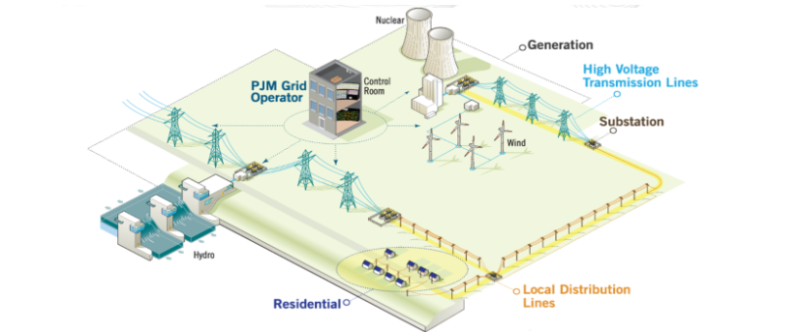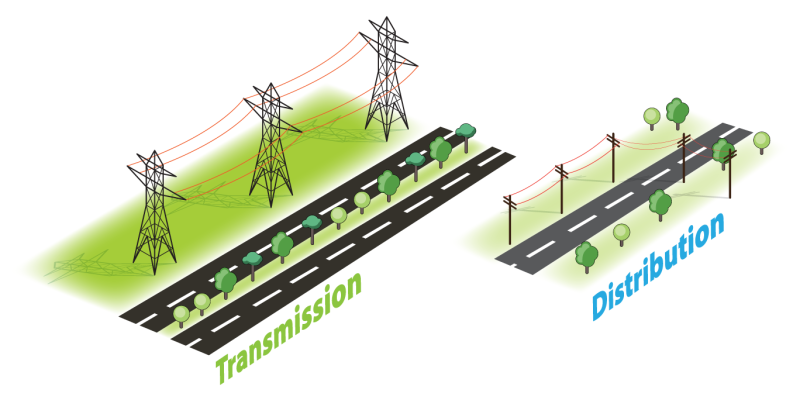By: Clara Summers
Campaign Manager
Consumers for a Better Grid (a project of CUB)
The long transmission lines that crisscross the country are key to keeping our lights on and getting cleaner, more affordable energy to the people who need it most. But like most things in life, they don’t come free. This Q&A illustrates where we pay for transmission on our power bills.
What is transmission?
Transmission refers to the complex network of high-voltage, high-capacity power lines that carry bulk energy from generating stations (power plants) across the country and eventually to local distribution systems that serve our homes. These interstate highways of our electricity system are built by big companies, called “transmission owners.” The flow of electricity over these lines as well as the planning of interstate transmission projects are managed by power grid operators, called Regional Transmission Organizations (RTOs). Illinois is served by two RTOs: the PJM Interconnection and the Midcontinent Independent System Operator (MISO).
What’s the difference between transmission and distribution lines?|
It’s important to distinguish between transmission, the delivery of high-voltage electricity over lines that span the country, and distribution, the delivery of electricity from substations over lower-voltage wires in our neighborhoods.
| Transmission vs. Distribution | Distribution | Transmission |
| Voltage | Less than 34 kilovolts | 115-765 kilovolts, or more. |
| Area Covered | Relatively small geographic area, near homes. | Large geographic area, spanning states and regions. |
| Connect… | Substations to homes. | Substations to power plants. |
| We pay for this through all or part of the… | Delivery section of our power bills. | Supply section of our power bills. |
| Rates Determined by… | Processes before state regulators. | Processes before regional power grid operators and federal regulators. |
Why do we need transmission?
Transmission is key to reliability, sustainability and affordability. Transmission lines move electricity from where it is produced to where it is used. During an extreme weather event, transmission can move electricity from places that are unaffected by the storm to the places that are in crisis. Transmission is also key to unlocking the full benefits of the clean energy transition, because it is often more efficient and cheaper to locate wind or utility-scale solar far from where it is consumed. According to some estimates, we need to double or triple our transmission capacity to transition to a clean, affordable energy system free of the carbon pollution that’s harming our climate.
While transmission plays a critical role in our energy system, it must be well-planned and cost-efficient, and that’s where CUB is interested in advocating for consumers.
Where do I pay for transmission on my electric bill?
In the case of Illinois’ two biggest electric utilities, ComEd and Ameren, transmission-related costs have their own line item. For example, on ComEd bills the charge is typically the “Transmission Services Charge” but if you have an alternative supplier it’s called the “Utility Transmission Charge.” On Ameren bills it’s the “Transmission Service Charge.” See the images below.
ComEd:

Ameren:

How much of our bill do these charges take up?
Although residential and commercial electric customers ultimately pay for transmission on our bills, the actual transmission customer is the electric utility, co-op or alternative supplier that purchases wholesale power and uses the transmission lines to transport the power and resell it to us, the end-use customers. The initial billing for these charges is managed by power grid operators (RTOs like PJM or the MISO) before the utility bills us.
Over the past decade, the cost of transmission in the PJM region has increased by 182 percent. Transmission owners make more money when projects are more expensive, so they don’t have an incentive to keep costs down by planning prudently or using cost-cutting technologies. These costs eventually trickle down to retail customers like you and me, and they are a growing burden.
Who determines what we pay for these charges?
The Federal Energy Regulatory Commission (FERC) approves a formula for transmission owners to use when setting rates. This rate is charged to wholesale customers based on the “cost of service.” That’s the amount needed for the utility to recover the costs spent on providing transmission service, plus a return on the utility’s capital investments. While PJM has a process for planning interstate transmission, many in-state transmission projects, known as “supplemental projects,” escape review entirely.
Who advocates for consumer interests regarding these charges?
Because end-user electric customers (you and your neighbors) eventually bear the cost of transmission, it is important for consumer advocates to make sure the transmission owners are planning and spending prudently. That’s why CUB started Consumers for A Better Grid, a campaign which partners with other advocates to get involved with the RTOs and FERC. We also advocate at PJM for better capacity market policies. There’s a lot of work to do! If you want to learn more, visit ForABetterGrid.org.

About the Author
Clara Summers joined CUB in 2023. She spearheads the Consumers for a Better Grid (formerly CLEAR RTO) campaign, which advocates for a cleaner, more affordable power grid for the 65 million people served by PJM, the nation’s largest grid manager. Clara is based in the greater DC area. When not deep in the weeds of energy policy, she enjoys Irish dance, hammered dulcimer, and anything to do with koalas.



